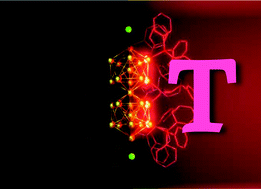Masaaki Mitsui, Yuki Wada, Ryoto Kishii, Daichi Arima and Yoshiki Niihori
Nanoscale, 2022,14, 7974-7979
DOI:
10.1039/D2NR00813K,
Communication
In photoluminescence (PL) quenching and triplet fusion upconversion experiments with fluorescent organic-molecule quenchers, it was revealed that a rod-shaped, phosphine- and thiolate-protected biicosahedral Au25 cluster (a representative di-superatomic molecule) exhibits only phosphorescence, not fluorescence, at room temperature with an intersystem crossing quantum yield of almost 100%. By virtue of these photophysical properties, this cluster can be used as a triplet sensitizer that undergoes direct singlet–triplet transitions in the near-infrared (NIR) region (730–900 nm), inducing photon upconversion from NIR to visible light.
